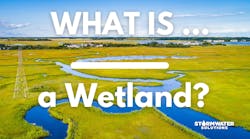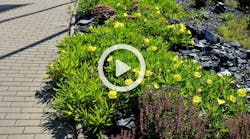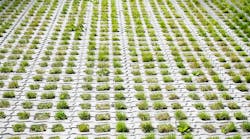Green infrastructure solutions for urban stormwater management
Urban stormwater management presents complex challenges, from increased runoff due to impervious surfaces to the heightened risk of flooding and water pollution. As metropolitan areas expand, traditional infrastructure often falls short of managing the rising volumes of stormwater, especially with the growing frequency of extreme weather events linked to climate change.
This is where green infrastructure becomes essential. Integrating natural elements like permeable pavements, green roofs and bioretention systems helps reduce flooding risks and enhance water quality. They mimic natural processes and offer a more resilient and sustainable approach to help cities adapt to changing climate conditions while maintaining the health of urban ecosystems.
1. Permeable pavements
Permeable pavements offer a practical solution for urban stormwater management by allowing water to infiltrate through surfaces rather than running off into storm drains. This reduces the volume of runoff and helps prevent localized flooding. Letting rainwater pass through can also minimize the need for road salt in winter, as water does not pool and freeze as quickly. Additionally, permeable pavements can lower construction costs for residential and commercial developments by reducing the need for extensive stormwater infrastructure, like drains and retention basins.
Recent advancements in materials and design have made permeable pavements even more effective and durable. For high-traffic areas, manufacturers offer porous concrete, asphalt blends and interlocking pavers to maintain structural integrity while allowing water to seep. These materials handle heavy loads without compromising permeability, making them suitable for urban streets, parking lots and commercial driveways.
2. Bioretention systems and advanced rain gardens
Bioretention systems are engineered to filter and slow down stormwater, blending natural processes with advanced design. These systems use shallow, vegetated basins where runoff is collected and gradually filtered through soil layers. As the water seeps through, the soil and plants filter out pollutants like sediments, heavy metals and nutrients before they reach groundwater or nearby streams. This method reduces peak stormwater flow and helps improve water quality.
Unlike conventional pipe-based drainage, bio-retention systems deliver high-quality drainage by allowing water to be naturally filtered and absorbed. Advanced rain garden designs take this concept further by using native plant species that are better adapted to local conditions. Native plants typically have deep roots, which increase soil permeability and provide more pathways for water to infiltrate. These plants also excel at removing pollutants, offering an efficient way to purify stormwater.
3. Hybrid green and gray infrastructure approaches
Integrating traditional gray infrastructure with green solutions offers a balanced approach to managing extreme weather events in urban settings. Floodwalls provide a physical barrier against rising water levels to protect communities and critical infrastructure from inundation. Modern floodwalls feature connectors and gates that operators can adjust to release water. This flexibility ensures the excess can be diverted during intense rain events, helping maintain control and keep vulnerable areas dry.
They become even more effective when combined with green infrastructure like constructed wetlands. During peak flow events, flood walls can channel excess water toward these wetlands to allow nature-based solutions to absorb and filter the overflow. This approach helps manage flood risks, improves water quality and enhances local ecosystems.
4. Green roofs and blue roofs integration
Green and blue roofs serve distinct yet complementary roles in urban stormwater management. Green roofs support vegetation, allow plants to absorb and filter rainwater, and improve air quality and habitat creation. They help slow down runoff and reduce the strain on drainage systems during heavy rain events. Blue roofs focus on temporarily storing rainwater in controlled amounts before slowly releasing it. They have drainage control devices that temporarily retain water, reducing the peak flow rates into stormwater systems.
Innovative hybrid systems combining green and blue roof technologies offer a more integrated approach. These systems often feature a layered design, where a blue roof component captures and stores water while a green roof layer uses some of this retained liquid for plant growth. Additionally, the vegetation on green roofs insulates buildings and mitigates the urban heat island effect. Meanwhile, the retention capabilities of blue roofs enhance thermal regulation.
5. Constructed wetlands for urban areas
Constructed wetlands are a powerful tool in urban stormwater treatment, particularly when managing large runoff volumes during heavy rain events. With dozens of major United States cities experiencing more flood days over the past decade, these engineered ecosystems provide a natural solution for handling excess water. Constructed wetlands mimic natural marshes, allowing stormwater to flow through layers of soil and dense vegetation that trap sediments and absorb excess nutrients. This process reduces the burden on existing infrastructure and minimizes the risk of urban flooding.
Designing effective constructed wetlands requires focusing on factors like flow path optimization, substrate selection and plant choices. Optimizing the flow path ensures water has adequate time to interact with plants and soil, which enhances pollutant removal. Selecting the proper substrates, such as a blend of sand, gravel and organic matter, supports plant growth and boosts the system’s filtration abilities. These design considerations create a highly effective solution for urban areas facing increased risks, blending natural processes with strategic engineering.
6. Smart stormwater control systems
Artificial intelligence (AI) and the Internet of Things (IoT) optimize the operation of green infrastructure, mainly via technologies like automated valves and sensors for flow control. These systems enable real-time monitoring of water levels, flow rates and overall system performance, allowing for immediate adjustments based on current conditions.
For example, automated valves can open or close to regulate flow during heavy rainfall. This dynamic control helps cities maximize the efficiency of their green infrastructure to ensure optimal water management during varying weather conditions.
Beyond stormwater control, AI and the IoT contribute to energy efficiency, building performance and environmental sustainability. These technologies collect and analyze data on energy use, weather patterns and building operations to fine-tune systems like air conditioning, heating, lighting and water management.
In urban stormwater management, a data-driven approach allows AI to predict rainfall patterns and adjust green infrastructure systems accordingly. Analyzing weather data and historical patterns enables AI systems to anticipate heavy rains and prepare facilities to handle increased flow.
Adopting innovative solutions for a resilient future
Professionals should consider integrating these innovative approaches into urban stormwater management to boost resilience and improve water quality in urban areas. Embracing hybrid solutions can provide long-term benefits in managing increasing rainfall and climate variability. Advancements such as AI-driven forecasting and adaptive green infrastructure designs promise greater efficiency in addressing urban challenges.
About the Author
Emily Newton
Editor -in-chief
Emily Newton is editor-in-chief of Revolutionized. Newton can be reached at [email protected].





